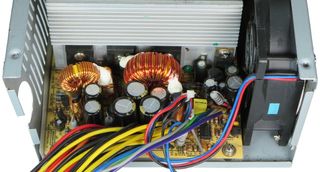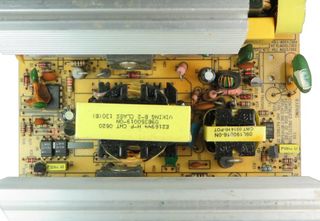PSU Repair: A Case Study
When your PSU won't start, most enthusiasts don't go beyond a paperclip or multimeter check. Today, we'll do a comprehensive repair of Antec's old SL300.
Do We Have A Definitive Fix?
Recap
I started out with a whiny power supply that would not reliably turn on, discovered that I could make it become predictable by loading down the 5VSB output and decided to start working backwards from there. In the end, I got it to function properly without crutches using $2 worth of new caps, even if they didn't fit on the board quite right. Of course, that was on top of the $3 worth of capacitors I replaced back in 2009.

Looking back at the results, I believe I can put together the sequence of events that lead to this failure: putting my Core 2-based machine into standby on a regular basis, something I rarely did on my Pentium III, wore down the under-rated 5VSB output caps. As they got worse, ripple on the auxiliary capacitor also increased until it failed while the main outputs were off. Beyond that point, the PWM's capacitor was alone and the power supply continued chugging along until its ESR became too high and the supply would no longer turn on.
Disconnecting the unit from the motherboard removed the load and board capacitors, which provided some clamping for the 5VSB output like my external capacitor did. This allowed surges on the auxiliary output to reach levels high enough to flash over inside the dead auxiliary capacitor, and once the capacitor had warmed up enough from it, contact got made and the power supply would work normally again until the next time it cooled down. Adding load on the 5VSB rail caused the 5VSB's pulse rate to increase. Once the load was sufficient to make the pulse period shorter than the voltage decay time on the PWM's bypass capacitor, the power supply would turn on properly again even when cold.
The increased 5VSB voltage before the auxiliary capacitor replacement was likely caused by the flyback circuitry using its own auxiliary output supply to shut itself off based on the 5VSB feedback. With no power to operate the primary side of the feedback circuitry after the auxiliary voltage dies off from the dead cap not holding a charge, a new flyback cycle starts even if not required and the voltage rises.
In Retrospect
Thinking back to the earliest days when this power supply started giving me trouble after my first repair attempt, I vividly remember hearing an irritating whining noise coming out of my speakers with a pitch that shifted in time with the blinking of my PC's standby LED about a year later. I actually ended up buying an EA650 for my Core 2 and put the SL300 in one of my spare PCs until I reused the EA in my i5-based system. I would not be surprised if that happened to be the very first hint of trouble on the 5VSB and auxiliary outputs. As shown in my preliminary tests, even a 50mA change had a significant impact on the flaky 5VSB's behavior. With the fixes, load on 5VSB makes hardly any difference whatsoever anymore.
Conclusion
Throw in a proper $0.50 PCB-mount fuse to replace my thin wire fuse hack, a pair of 8mm capacitors with at least one of them rated for 2A ripple that fit properly for the 5VSB output and perhaps something with the correct lead spacing for the auxiliary cap--that's what I would call a definitive fix. Would I use this supply in a PC again? Sure, but not in anything beyond a spare system until I got around to putting proper parts in and doing some more testing.

Should you attempt to repair decade-old $40 power supplies? Most likely not. Even if you have the knowledge, skills, tools and parts to do it safely and properly, buying a new $40 power supply may still end up cheaper than the repair once you account for your time. Also, the new unit will usually be considerably more efficient and contain only minty-fresh components, complete with manufacturer warranty coverage. It only made sense to me because I could satisfy my own curiosity and do something useful with my oscilloscope. Having spare known-good power supplies with high performance caps never hurts either.
Next in my repair queue: the proprietary form factor supply from my Antec Aria case. It is the worst case I have personally worked with to date, made worse by the Pentium 4 (3GHz Northwood with HT) I put in it and the effectively nonexistent ventilation through it, especially in the processor area. The CPU fan is screaming even at idle when all three covers are on. If you want to read about that, let me know in the comments!
MORE: How We Test Power Supplies
MORE: Who's Who In Power Supplies, 2014: Brands Vs. Manufacturers
MORE: All Power Supply Content
MORE: Power Supplies in the Forums
MORE: How To Build A PC: From Component Selection To Installation
Daniel Sauvageau is a Contributing Writer for Tom's Hardware. Follow him on Twitter and Google+.
Stay On the Cutting Edge: Get the Tom's Hardware Newsletter
Join the experts who read Tom's Hardware for the inside track on enthusiast PC tech news — and have for over 25 years. We'll send breaking news and in-depth reviews of CPUs, GPUs, AI, maker hardware and more straight to your inbox.
-
Nuckles_56 An interesting read, it was interesting following the process you used to troubleshoot the problemReply -
Crashman I used to do this for a living :)Reply
Don't tell my boss, I've managed to convince him that I'm only an expert at running benchmarks and writing about the results :) -
epsiloneri Disclaimers won't help. The people who will likely hurt themselves trying this are the same who lack the reading comprehension and self awareness to understand those disclaimers are directed at them. I admire you courage in publishing this.Reply
-
beetlejuicegr the truth is the paper clip and multimeter is all i can go in to psus. after all i haven't studied electricity or circuits or whatever.Reply
However i do hate to throw stuff earlier than it should, like you. -
C12Friedman I like this article and I fully agree with the conclusion. I've repaired a few PSU's but, for the most part I scavenge them anymore since I can't put them in a new system (nor would I want to) IMO they aren't really worth anything other than for on a test bench.Reply -
Mr A Daniel, I know next to nothing about electronics, and yet I could not stop reading this article. Fascinating! Thanks very much!Reply -
Urzu1000 This was a great article! It was informative, as well as interesting. Personally, I've only had one PSU fail on me so far. My brother-in-law's self-built computer had a really low-end Thermaltake PSU. 800W Bronze, and oh man, did that thing go out in a blaze of glory. Very loud popping, and smoke, and funny smells. When I ripped it out of the computer, there were burns inside the case. Miraculously, the other components remained unharmed, so I slapped in a new PSU (750W Gold Seasonic) and fired it up.Reply
Still working good, but I get black soot on my hands every time I open up that case. It's a black case, so it's hard to clean it off properly. -
Interesting article. I would have simply replaced the entire unit. You saw how to fix the failure, but how many units were damaged that you didn't see? A ticking time bomb that will eventually send some spike to your much more valuable hardware than a 10 year old PSU. Wasteful, yes. I get it. I don't like to waste either. And if it's on marginal hardware, fine. But on primary systems I'm not willing to take the risk. I'd rather throw away a 200$ part that has a 0.05$ repair solution, than risk frying 800$+ hardware.Reply
-
kalmquist "Antec's manufacturer (Channelwell in this case) got the live and neutral wires backwards, which means that in the “off” position, the neutral line gets opened and everything on the primary side becomes live instead of neutral."Reply
That's really bad--I doubt it is even legal to sell a power supply wired like that. I've never bought a CWT (Channelwell) power supply, and based on this I wouldn't buy one, except perhaps for a high end model where you might gamble that the company would exercise a bit more care.
